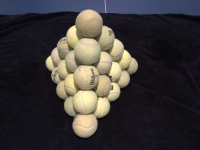Thread Rating:
Poll
 | 1 vote (8.33%) | ||
 | 2 votes (16.66%) | ||
 | 2 votes (16.66%) | ||
 | 3 votes (25%) | ||
 | 2 votes (16.66%) | ||
 | 1 vote (8.33%) | ||
 | 7 votes (58.33%) | ||
 | 2 votes (16.66%) | ||
 | 3 votes (25%) | ||
 | 2 votes (16.66%) |
12 members have voted

Click on image for larger version.
Imagine a stack of cannonballs arranged like a tetrahedron, as shown in the image above. What is the limit of the ratio of the volume of the entire pyramid to the volume of the cannonballs in the pyramid, as the size of the pyramid reaches infinity? In other words, what ratio of space in the pyramid isn't wasted with empty space?
Hint: See the previous math puzzle linked to above.
I know you can easily search on this one, so I want to see a full solution for the beer, not just a copy and paste of the answer from another site.
If not, it is possible for very tiny spheres to fill 100% of the pyramid.
Quote: AyecarumbaIs the stack always 5 layers?
If not, it is possible for very tiny spheres to fill 100% of the pyramid.
They would all be the same size. Infinite layers.
Is that picture on your ping pong table tennis table, Wizard?
Quote: RSThey would all be the same size. Infinite layers.
Correct!
Quote:Is that picture on your ping pong table tennis table, Wizard?
No, it's a ping pong table! Only snobs say "table tennis."
Q: Why is pirating so addictive?
However....
You�ve opened a can of worms here.Quote: WizardSince this is a thread about cannonballs, let's have some pirate jokes ...
What�s a pirate�s favorite restaurant?
But Pirate, you should not talk about Axelwolf, he got married to cover that up.Quote: WizardSince this is a thread about cannonballs, let's have some pirate jokes until somebody submits a real answer.
Q: Why is pirating so addictive?
Quote: DJTeddyBearMost of your math puzzles are beyond me.
However....You�ve opened a can of worms here.
What�s a pirate�s favorite restaurant?
Arrrrr by's
"Yo, Ho's hoeing"
What is a pirate's favorite letter?
RRRRRRRRRRR
and that used to be the end of the joke
but wait, that's not all!
No, the pirate's true love is the C!
Quote: DJTeddyBearWhat�s a pirate�s favorite restaurant?
Quote: Ayecarumba
"Yo, Ho's hoeing"
*groan*
Quote: WizardQuote: Ayecarumba
"Yo, Ho's hoeing"
*groan*
hehe.... Thank you... I'm here all week...
3 pirates walk into Girlie Gertie's Guest house and want a room for the night - as the crew replenishes the ships needs.
The barmaid says it will be 15 gold coins for the night.
They each pay 5. (which equals 15 for you really simple pirates).
Later, she realizes it was only supposed to be 10 gold coins for the night - but can't divide 5 coins into 3 pirates.
So she gives them each 1 coin back each and keeps 2 for herself (crafty wench).
So now each pirate has paid 4 coins each.
4 coins x 3 pirates = 12 coins. Plus the 2 she kept = 14 coins.
Where did the other coin go?
Quote: gordonm888Where did the other coin go?
This one is one of my favorites. I know the answer so will give the rest of the forum a chance to enjoy it.
Quote: gordonm888This is a pirate-themed variation of other puzzles that have been posted in the murky past.
3 pirates walk into Girlie Gertie's Guest house and want a room for the night - as the crew replenishes the ships needs.
The barmaid says it will be 15 gold coins for the night.
They each pay 5. (which equals 15 for you really simple pirates).
Later, she realizes it was only supposed to be 10 gold coins for the night - but can't divide 5 coins into 3 pirates.
So she gives them each 1 coin back each and keeps 2 for herself (crafty wench).
So now each pirate has paid 4 coins each.
4 coins x 3 pirates = 12 coins. Plus the 2 she kept = 14 coins.
Where did the other coin go?
gordonm888,
Huh? In the end the pirates paid 12 coins: 10 to the innkeeper, and 2 to the barmaid.
Why are you adding the pirates' outlay to the barmaid's intake?
Dog Hand
The barmaid kept 2 gold coins as a tip.
So at this point the pirates actually paid 13 gold coins to the guest house and 2 gold coins to the barmaid.
Then the barmaid returns 3 gold coins to the pirates.
So the pirates paid 10 gold coins for the room and 2 gold coins to the barmaid.
10 gold coins +2 gold coins = 12 gold coins = 3*4 gold coins.
Quote: WizardI have yet to see a satisfactory explanation about the missing coin. Let me rephrase the question. The pirates originally paid 15 coins. In the end, they each paid 4 coins to the innkeeper and the wench got two. 4*3 + 2 = 14. Where's the 15th coin?
Here's one:
There is no "15th coin." You are mixing coins being paid with coins being collected. The wench's 2 coins are part of the 15 the pirates eventually paid out; the other three were given back to the pirates.
Quote: unJonMy differential equation (dif eq) professor in college is actually the person that proved that stacking cannonballs in this way is the most efficient way to stack them.
One of the MAA's annual high school exams (now called the AMC 12) in the late 1970s asked the question, "If four balls of radius 1 are stacked in a tetrahedron shape, what is the length of the side of the tetrahedron that circumscribes the structure?"
Quote: ThatDonGuyHere's one:
There is no "15th coin." You are mixing coins being paid with coins being collected. The wench's 2 coins are part of the 15 the pirates eventually paid out; the other three were given back to the pirates.
Well said! That I accept. I submit that OnceDear owes you a beer.
The way I explain it is to mention, as you did, that the 14 coins is mixing money paid and money received. There are two ways to look at it:
Money paid: Three men paid $4 each = $12
Money received: The innkeeper received $10 and the wench got $2 = $12

Quote: WizardWell said! That I accept. I submit that OnceDear owes you a beer.
He can chip in when you buy that round you promised to "pay off my tab" of beers you owe me at Spring Fling...
Quote: ThatDonGuyHe can chip in when you buy that round you promised to "pay off my tab" of beers you owe me at Spring Fling...
As long as that's getting close, we always just run a single tab. At the end, if nobody steps up to pay the whole thing, then we divide it up equally. How about I take $100 off the top and pay it, as your donation, and we divide up what is rest. I'll be sure to make an announcement about your contribution.
Quote: WizardAs long as that's getting close, we always just run a single tab. At the end, if nobody steps up to pay the whole thing, then we divide it up equally. How about I take $100 off the top and pay it, as your donation, and we divide up what is rest. I'll be sure to make an announcement about your contribution.
Sounds good to me.
Quote: ThatDonGuySounds good to me.
Sounds even better for us!
Quote: WizardThis is a follow-up to my math puzzle SPHERE INSCRIBED IN A TETRAHEDRON.
Click on image for larger version.
Imagine a stack of cannonballs arranged like a tetrahedron, as shown in the image above. What is the limit of the ratio of the volume of the entire pyramid to the volume of the cannonballs in the pyramid, as the size of the pyramid reaches infinity? In other words, what ratio of space in the pyramid isn't wasted with empty space?
Hint: See the previous math puzzle linked to above.
I know you can easily search on this one, so I want to see a full solution for the beer, not just a copy and paste of the answer from another site.
I think this is just a hexagonal-close-packed (HCP) array of spheres. In materials science, there are entire areas of diagnostic techniques -such as x-ray diffraction and neutron diffraction - that deal with this geometry and are used to explore for defects or the inclusion of other materials in an HCP lattice and produce 3-D maps of such materials . The volumetric packing efficiency for an HCP array of spheres of identical size is worked out in many materials text-books and is fundamental to this field of materials science, and I don't think it ,matters whether it is for a pyramidal volume or for an infinite volume - because an infinite volume can be divided into pyramids.
I have been avoiding answering this puzzle because I have some textbooks on a shelf in my office that surely must have this HCP analysis, and since I paid for those damn textbooks (a long time ago) I will pass on grinding out the ab initio derivation.


